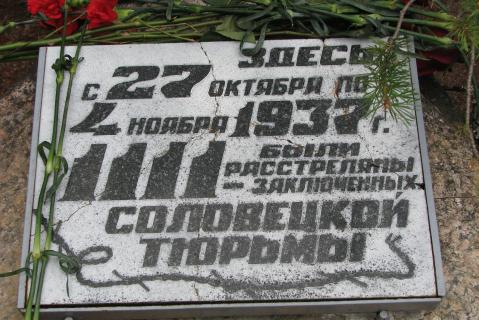The capital of the Belbaltlag camp complex (1931-1941) was located in Medvezhegorsk. It is not known when the wooded area now called Sandarmokh became a killing field for Belbaltlag prisoners or whether it was the only such execution site in the Medvezhegorsk district. Executions somewhere in the area are confirmed in archival documents. Inhabitants of Karelia, forced settlers, and prisoners were all shot here during the Great Terror. Historians believe that a considerable proportion of those executed in Karelia were shot at Sandarmokh. A transport of 1,111 prisoners from the Solovki special prison were also brought to the clearing and shot there between 27 October and 4 November 1937.
*
Many years spent searching for this “lost transport” led to the discovery of the killing field at Sandarmokh on 1 July 1997 by a joint expedition of the Petersburg and Petrozavodsk Memorial. With the support of the district administration, they found 150 grave pits, measuring 4x4 metres, two of which were opened in the presence of a representative of the Medvezhegorsk district prosecutor’s office. Indirect estimates indicate that up to 4,500 bodies were buried in these pits – many more than those of the lost transport from Solovki.
After further investigation, and an assessment by the prosecutor’s office, the Memorial society proposed that a memorial cemetery be created on the site, and this suggestion was supported by the Karelian government and the Medvezhegorsk district administration. In that same year, an asphalt road was laid to the area and a wooden Orthodox chapel dedicated to St George was erected there. The cemetery was formally opened on 27 October 1997. Since then over 400 individual grave markers have been placed on the graves; Orthodox and Catholic crosses have been erected there; a plaque commemorating the executed Solovki prisoners; and more than thirty ethno-confessional memorials.
Since 1998 the memorial complex has marked International Days of Remembrance each year on 5 August, attended by people from Karelia, other parts of Russia and delegations from Ukraine, Poland and elsewhere, as well as members of the diplomatic corps.
The Commemorative Lists of Karelia, 1937-1938, compiled by Ivan Chukhin & Yury Dmitriev, were published in 2002 (1,087 pp). The online version contains biographical entries for 14,038 individuals.
The online Memorial database (2025) lists 13,408 victims in Karelia. (See Petrozavodsk.) 11,317 were shot. 1,998 were sent to a variety of camps where 424 died.
The lists indicate that 4,974 were shot “at the Medvezhya Gora rail station”, a reference to the place now known as Sandarmokh.
| Date | Nature of ceremonies | Organiser or responsible person | Participants | Frequency |
|---|---|---|---|---|
|
5 August
|
International Day of Commemoration of the Victims of Political Repression
|
Medvezhegorsk district administration, Memorial Research & Information Centre (St. Petersburg)
|
Officials of the Karelian Republic, the Medvezhegorsk district administration and Pindushi urban settlement; members of the Memorial Society, representatives of ethnic and confessional groups in Karelia; international delegations, diplomats and relatives of victims
|
Annual event since 1998
|
|
30 October
|
Remembrance Day for the Victims of Political Repression
|
Medvezhegorsk district administration
|
Medvezhegorsk district administration, Pindushi urban settlement, public organisations, local population, relatives of the victims, schoolchildren
|
Annual event
|
| State of burials | Area | Boundaries |
|---|---|---|
|
Characteristic topsoil subsidence over common graves
|
7 hectares
|
partially delineated
|
[ original texts and hyperlinks ]
Archive of the Memorial Research & Information Centre (St Petersburg)
“Sandormokh memorial complex”, Virtual Museum of the Gulag [retrieved on 26 May 2022; not accessible]
“Executions in Karelia (1937-1938)” Dmitriev Affair website (accessed 30 December 2024) {in English}
*
Reply [2 pp. 1 location] by the Medvezhegorsk district administration (№ 9/7-11/30/1534 of 14 May 2014) to a formal enquiry by RIC Memorial (St Petersburg)
Reply [4 pp. 5 locations] by the Karelian Republic ministry of culture (№ 1815/11-1-15 of 5 May 2014) to a formal enquiry by RIC Memorial (St Petersburg)




